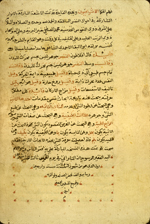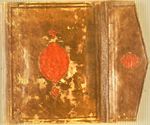- The Rays Gleaming with Radiating Lights Concerning the States of the Rational Soul)
- الاشعه البارقه بالانوار الشارقه فى احوال النفس الناطقه
- by Abū al-Baqā’ al-Aḥmadī al-Shāfi‘ī (fl. between 1030 and 1650 AD)
- ابو البقاء الاحمدى الشافعى
This is a commentary on a poem by Ibn Sīnā (Avicenna, d. 1037/438) titled al-Qasidah al-‘ayniyah (The Poem on the Soul), concerned with the soul and its relationship to the body.
Virtually nothing is known of the commentator. He is recorded by Hajji Khalifah (Katib Celebi) as the author of a commentary (sharh) on a takhmis (a special type of amplification of poetry) written by an otherwise unknown scholar named Mansur al-Misri on Ibn Sīnā's poem al-Qasidah al-‘ayniyah.
Since Hajji Khalifa died in 1657/1067, we can conclude that Abu
al-Baqa' al-Ahmadi must have worked sometime between the mid-11th century (when Avicenna died) and the mid-17th century (see Hajji Khalifah, Kashf al-zunun: Lexicon bibliographicum et encyclopædicum,
ed. G. Flügel, 7 vols., Leipzig: Typis Frider. Chr. Guil. Vogelii /
London: Richard Bentley for the Oriental Translation Fund of Great
Britain and Ireland, 1835-58, vol. 4, p. 544).
The manuscript at NLM (MS A 2) was copied in 1733/1146 and it contains a commentary made by Abū al-Baqā’ al-Aḥmadī directly on the poem itself by Ibn Sīnā, and not on the takhmis written by Manṣūr al-Miṣrī.
No other copy is recorded.
Berlin, Staatsbibiothek, MS We.56, fol. 96a-97b (Ahlwardt, Berlin, entry 5353), contains what appears to be a commentary by bū al-Baqā’ al-Aḥmadī on the takhmis by Manṣūr al-Miṣrī, which is an expansion of Ibn Sīnā's poem al-Qasīdah al-‘aynīyah. The Berlin manuscript in fact has no author specified for either the takhmis or the commentary, but bū al-Baqā’ al-Aḥmadī is proposed by the cataloguer as the author of the commentary, and Manṣūr al-Miṣrī for the takhmis, on the basis of Ḥājjī Khalīfah's statement. The commentary in the NLM copy (which specifically names bū al-Baqā’ al-Aḥmadī) is not the same as the commentary in the Berlin manuscript, and there is no takhmis in the NLM copy. A reference is given to the Berlin manuscript in GAL, vol. 1, p. 455 (594) 35q.
For Ibn Sīnā's poem al-Qasīdah al-‘aynīyah, see Yayha Mahdavi, Fihrist nuskhaha-I musannafat-I Ibn-I Sīnā (Tehran: Tehran UniversityPress, 1954), entry 99; and Jules L. Janssens, An Annotated Bibliography on Ibn Sīnā (1970-1989), including Arabic and Persian Publications and Turkish and Russian References (Ancient and Medieval Philosophy, De Wulf-Mansion Centre, 1st ser.,13), Leuven: University Press, 1991, p. 54.
al-Ashi‘ah al-bāriqah bi-l-anwār al-shāriqah
fī aḥwāl al-nafs al-nāṭiqah (MS A 2)
Illustrations
The final page of a commentary by Abū al-Baqā’ al-Aḥmadī al-Shāfi‘ī on the poem al-Qasīdah al-‘aynīyah (The Poem on the Soul)
by Ibn Sīnā (Avicenna). The title of the commentary can be read in the
first two lines, with the commentator named given in the fifth line. At
the bottom of the colophon, the copy is dated 13 Jumadá I 1146 (= 22 October 1733) and the scribe's name given as ‘Umar Suwaydān al-Munāwānī. No other copy is recorded.
The volume is bound in a Persian/Indian binding of the 18th or 19th century. It consists of dark-brown leather over pasteboards and includes an envelope flap.
In the center of each cover there is a panel stamp impressed over a
maroon-colored piece of leather cut roughly to the contours of the panel
stamp. A similar technique was employed for the two pendants on the
covers and the stamp on the envelope flap. The central stamp has a
shallow-scalloped ovoid outline with the inner field decorated in
relief with intertwined leaves and flowers. Leaves and stems decorate
the field of the envelope flap, and an abstract design was used for the
pendants. The frames on the cover and envelope flap are blind-tooled fillets that are almost inconspicuous.
Physical Description
Arabic. 20 leaves (fols. 1a-20b). Dimensions 20.6 x 15.5 (text area 16.5 x 8.5)cm; 23 lines per page. The title al-Ashi ‘ah al-bāriqah bi-l-anwār al-shāriqah
fī aḥwāl al-nafs al-nāṭiqah
is given on fol. 20b, lines 1-2, and on a modern paste-on label on
recent end-papers. On the mutilated title page (fol. 1a) the title is
given as: Anwār al-shāriqah sharh [fī aḥwāl] al-nafs al-nāṭiqah (The radiating lights, a commentary on the states of the rational soul). Ibn Sīnā (Avicenna) is named on fol. 1b, line 16, as the author of the treatise being commented upon. Abū al-Baqā’ al-Aḥmadī al-Shāfi‘ī, the author of the commentary, is named on fol. 20b, line 5.
The first line of Ibn Sīnā's al-Qasīdah al-‘aynīyah
is written in red on fol. 1b, line 19, with each word of the line
subsequently written separately in red and commented upon; this pattern
is followed for the entire poem. On fol. 20b, after the title of the
commentary and the commentator's name is given and before the colophon
at the bottom giving the date and the copyist, there is a short fa'idah, or useful note, citing Plato (Aflatun) as an authority.
The manuscript is dated in the colophon (fol. 20b lines 18-19) 13 Jumadá I 1146 (= 22 October 1733) where the copyist's name is given as ‘Umar Suwaydān al-Munāwānī.
The text is written in a medium-small naskh script, using black in with headings in an orange-red. There are catchwords.
There are marginalia in several hands, including textual corrections by the copyist.
The semi-glossy, stiff, cream paper has very fine vertical laid lines and single chain lines (no watermarks detected). The paper is along the front edges. Repairs have been made to the first and last leaves, and both are guarded.
The volume consists of 20 leaves.
Binding
The volume is bound in a Persian/Indian binding of the 18th or 19th
century. It consists of dark-brown leather over pasteboards and
includes an envelope flap. In the center of each cover there is a panel
stamp impressed over a maroon-colored piece of leather cut roughly to
the contours of the panel stamp. A similar technique was employed for
the two pendants on the covers and the stamp on the envelope flap. The
central stamp has a shallow-scalloped ovoid outline with the inner field
decorated in relief with intertwined leaves and flowers. Leaves and
stems decorate the field of the envelope flap, and an abstract design
was used for the pendants. The frames on the cover and envelope flap are
blind-tooled fillets that are almost inconspicuous. The spine and
envelope flap hinge are replacements. There are deep-orange paper endpapers and envelope flap lining; there are modern endpapers.
Provenance
The volume was purchased in 1941 by the Army Medical
Library from A. S. Yahuda (ELS No. 1256). No further information is
available on its provenance.
References
Schullian/Sommer, Cat. of incun. & MSS., A 2, p. 297, where there is a confusion of this commentary with both the commentary and the takhmis ascribed to Manṣūr al-Miṣrī in the Berlin manuscript.
NLM Microfilm Reel: FILM 48-110 no. 2


No comments:
Post a Comment